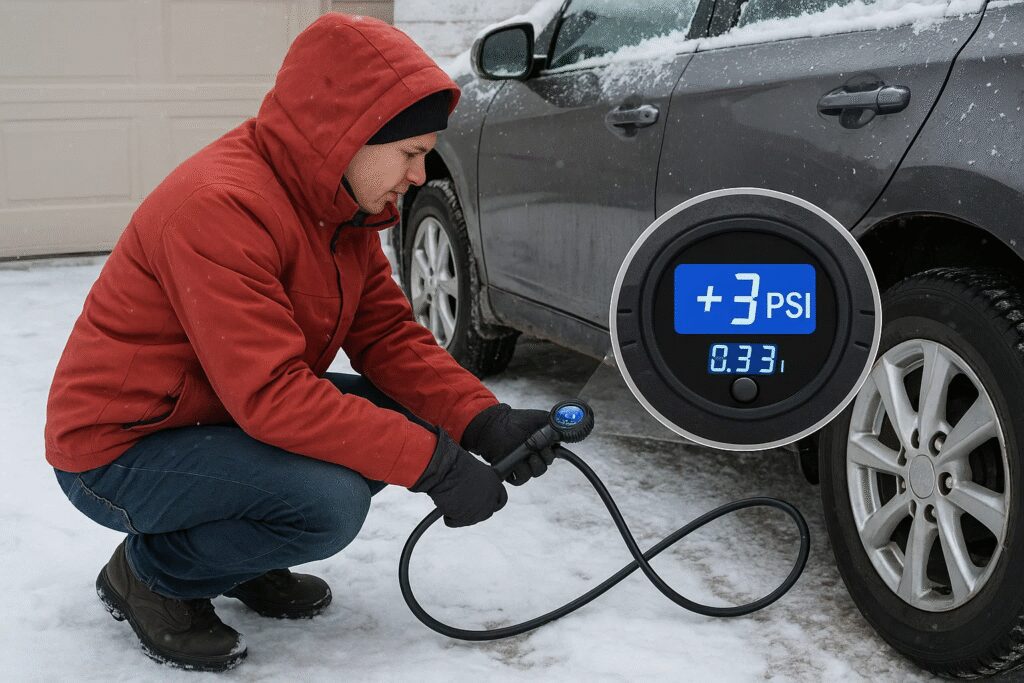Tyre pressure isn’t just about saving a few quid on petrol.
It’s about staying safe, stopping properly, keeping your tyres alive longer, and stopping your car from feeling like a jelly on wheels.
Yet loads of people just pick a “magic number” and forget that things like weather and how much you’re carrying can change what that number should be.
And now with extreme weather popping up more than ever in 2025
And people stuffing their cars full of kids dogs luggage and half the garage
Getting it right isn’t optional anymore
It’s essential.
🌡️ Why Weather Messes With Your Tyres
Think of the air in your tyres like a grumpy balloon.
It shrinks when it’s cold
It swells when it’s hot
And if you ignore it long enough
It pops.
Here’s the rough rule of thumb:
- Hot weather: Air expands about 1 PSI for every 10°F over 70°F
- Cold weather: Air drops about 1 PSI for every 10°F below 70°F
- Extreme heat: Can make tyres overinflate and even blow out
- Cold starts in winter: More rolling resistance and less grip
👨🔧 From the garage:
I’ve seen tyres blistered and cracked on scorching roads because drivers ignored the heat.
And in winter? Underinflated tyres make your steering feel like soggy spaghetti.
💼 How to Adjust for Extra Weight
Your tyres don’t magically toughen up when you pack the boot full of bricks
You need to help them out a bit.
- Just you and a passenger? Stick with what the door sticker says.
- Boot full of luggage or gear? Add 2–4 PSI to the rear tyres.
- Towing a trailer? Bump the rear up by 5–8 PSI (check your car’s towing guide).
- Driving fast round corners for fun? Add 1–2 PSI all round for a bit more stability.
Pro tip:
Always check and pump when the tyres are cold.
Once you’ve driven even a mile the readings start lying to you.
🔍 Real-Life Scenarios and What to Do
| Situation | Add or Subtract PSI | Why? |
|---|---|---|
| Normal weather (10–27 °C) | Use manufacturer’s PSI | Perfect balance |
| Hot summer (27–38 °C) | Drop by 1 or stay level | Air already expanding |
| Cold winter (below 0 °C) | Add 2 | Makes up for shrinking air |
| Car full of people & stuff | Add 2–4 to rear | Stops tyres sagging |
| Towing a trailer | Add 5–8 all round | Handles the weight |
🛠️ How to Check & Adjust Tyre Pressure Like You Actually Care
- Get a decent digital gauge. Those cheap stick ones? About as reliable as my uncle’s fishing stories.
- Check first thing in the morning before you drive.
- Use the PSI on the door sticker, not the scary big number on the side of the tyre.
- Add or release air a little at a time and keep checking.
- Recheck if the weather changes a lot or if you’ve loaded the car differently.
🚦 Why Getting it Right Really Matters
Here’s what you get when you don’t ignore your tyres:
✅ Better braking — stops you quicker when you need it.
✅ Even wear — tyres last longer and save you money.
✅ Better fuel economy — low pressure can cost you about 3% more fuel for every 1 PSI under.
✅ Lower blowout risk — especially important if you’re barrelling down the motorway in July.
👩🔧 Final Words From the Garage
Matching your tyre pressure to the weather and what you’re carrying is simple.
Takes you two minutes at the petrol station.
Costs nothing.
Saves you a fortune.
And it just might save your skin.
So next time you fill up
Grab the gauge
Check your tyres
And your car — and wallet — will thank you.
